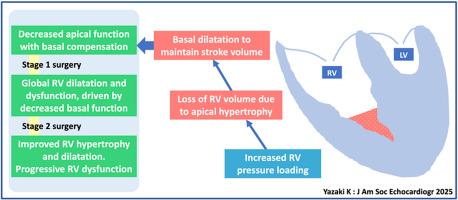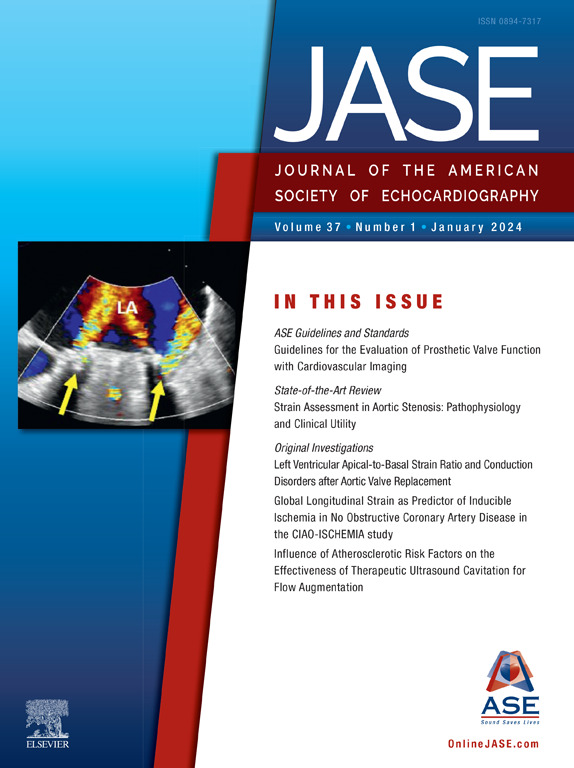左心发育不全综合征的局部右心室重构及其与整体右心室功能和临床结果的关系
IF 6
2区 医学
Q1 CARDIAC & CARDIOVASCULAR SYSTEMS
Journal of the American Society of Echocardiography
Pub Date : 2025-10-01
DOI:10.1016/j.echo.2025.05.021
引用次数: 0
摘要
背景:右心室(RV)重构和(不良)适应是左心发育不全综合征(HLHS)患儿高发病率和死亡率的原因之一。其机制尚不完全清楚。我们假设根尖肥大导致右心室体积损失,需要基础功能代偿,这决定了右心室功能和预后。因此,我们旨在研究HLHS中右心室肥厚重塑的区域模式及其与右心室功能的关系。方法:回顾性分析111例HLHS患儿和56例年龄匹配的对照组的纵向临床和超声心动图参数。为了评估右心室区域重构随时间的变化,对每位患者的6张超声心动图进行分析:(1)出生后,(2)一期手术后,(3)二期手术前,(4)二期手术后,(5)三期手术前,(6)最后一次超声心动图或心脏移植或死亡前。测量整体和局部右心室肥大、几何形状、功能和应变。为了评估基底和根尖缩短对总左心室射血的相对贡献,我们计算了基底和根尖分数面积变化(FAC)的比值。结果:与基础功能相比,1期前根尖功能受损。结论:1期前右心室基底功能下降伴根尖功能下降或右心室根尖肥大继发右心室体积缩小的患者移植风险较高。我们的研究结果促进了对HLHS中RV功能障碍的理解,并可能有助于对这些高危患者进行系列评估。本文章由计算机程序翻译,如有差异,请以英文原文为准。

Regional Right Ventricular Remodeling in Hypoplastic Left Heart Syndrome Across Staged Surgical Palliation and Its Association With Global Right Ventricular Function and Clinical Outcomes
Background
Right ventricular (RV) remodeling and (mal)adaptation contribute to high morbidity and mortality in children with hypoplastic left heart syndrome (HLHS). The mechanisms are incompletely understood. The authors hypothesized that apical hypertrophy leads to a loss of RV volume, necessitating basal functional compensation, which determines RV function and outcomes. Consequently, the aim of this study was to examine regional patterns of RV hypertrophic remodeling and their relationships to RV function in HLHS.
Methods
Longitudinal clinical and echocardiographic parameters in 111 children with HLHS and 56 age-matched control subjects were retrospectively analyzed. To evaluate RV regional remodeling over time, six echocardiograms were analyzed for each patient: (1) after birth, (2) after stage 1 surgery, (3) before stage 2 surgery, (4) after stage 2 surgery, (5) before stage 3 surgery, and (6) the last echocardiogram or before heart transplantation or death. Global and regional RV hypertrophy, geometry, function, and strain were measured. To evaluate the relative contribution of basal vs apical shortening to overall RV ejection, we calculated the ratio of basal to apical fractional area change (FAC).
Results
Before stage 1, apical function was impaired compared with basal function. After stage 1, RV sphericity (mid/basal ratio; P < .001) and hypertrophy (P < .001) increased, particularly at the apex (apical/basal ratio; P = .010). At the same time, global RV dilatation and dysfunction worsened, driven predominantly by decreased basal function. Patients with the lowest basal/apical FAC ratios (≤1.04) after birth tended to need transplantation (P = .07). After stage 2, RV hypertrophy (P < .001) and dilatation improved, accompanied by reduced shortening (RV FAC; P < .001) and longitudinal strain (P = .004), mainly at the base (P < .001).
Conclusion
Patients with decreased RV basal function concomitantly with decreased apical function before stage 1 or loss of RV volume secondary to RV apical hypertrophy may be at higher risk for transplantation. The present results advance understanding of RV dysfunction in HLHS and may aid in serial assessment of these high-risk patients.
求助全文
通过发布文献求助,成功后即可免费获取论文全文。
去求助
来源期刊
CiteScore
9.50
自引率
12.30%
发文量
257
审稿时长
66 days
期刊介绍:
The Journal of the American Society of Echocardiography(JASE) brings physicians and sonographers peer-reviewed original investigations and state-of-the-art review articles that cover conventional clinical applications of cardiovascular ultrasound, as well as newer techniques with emerging clinical applications. These include three-dimensional echocardiography, strain and strain rate methods for evaluating cardiac mechanics and interventional applications.

 求助内容:
求助内容: 应助结果提醒方式:
应助结果提醒方式:


